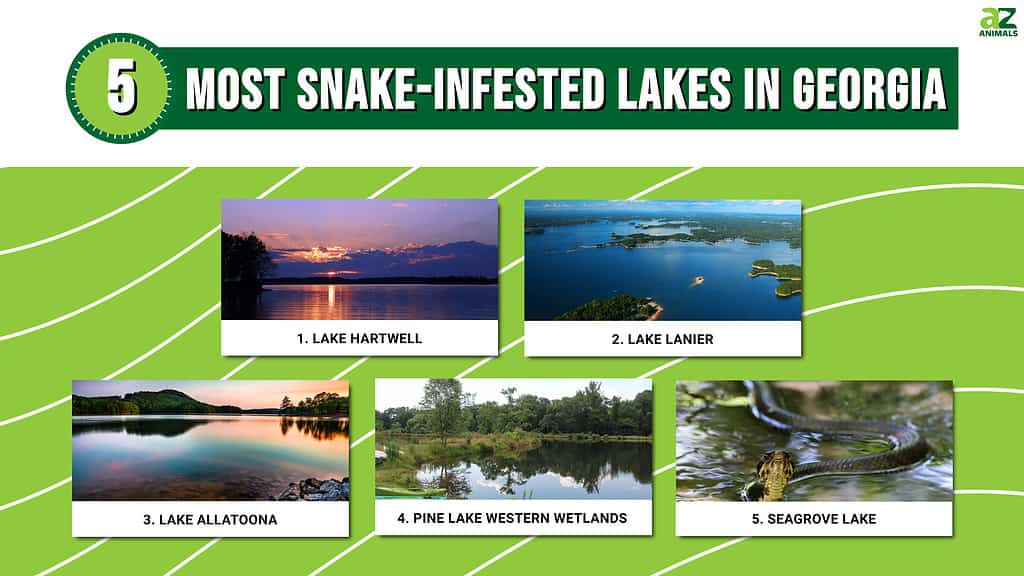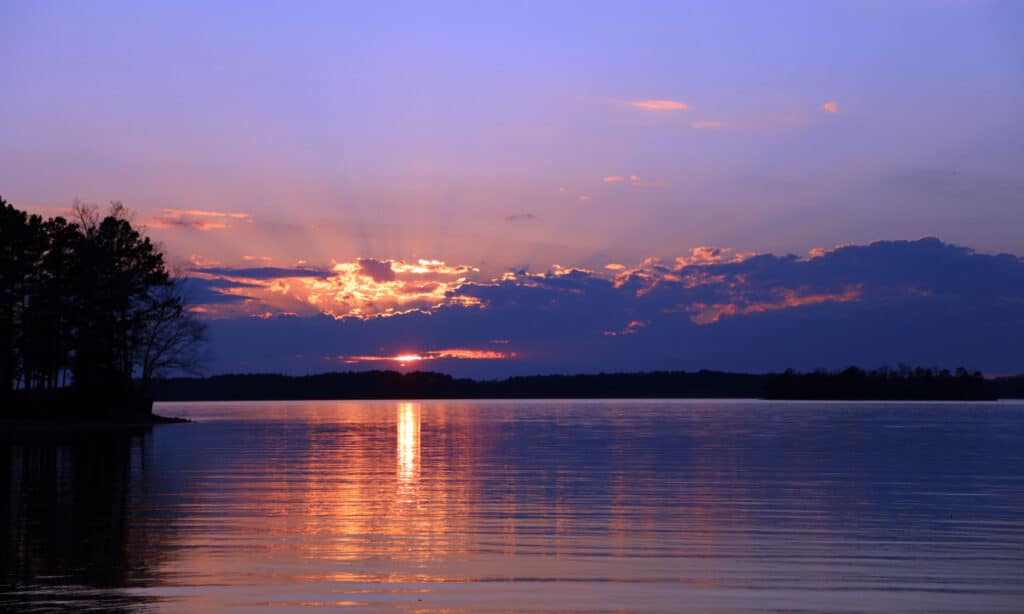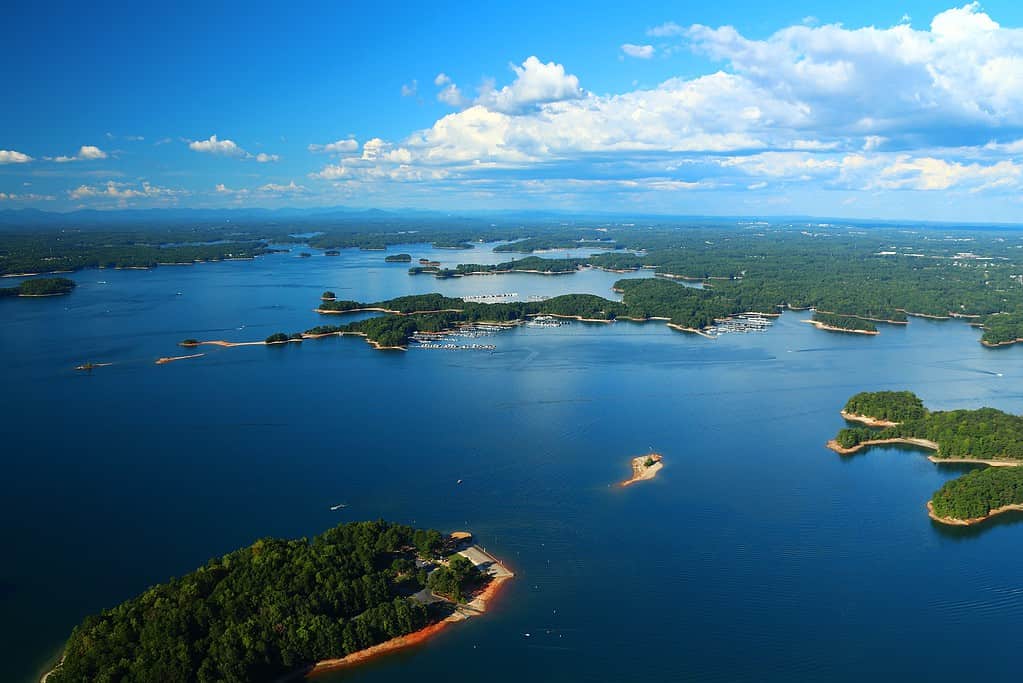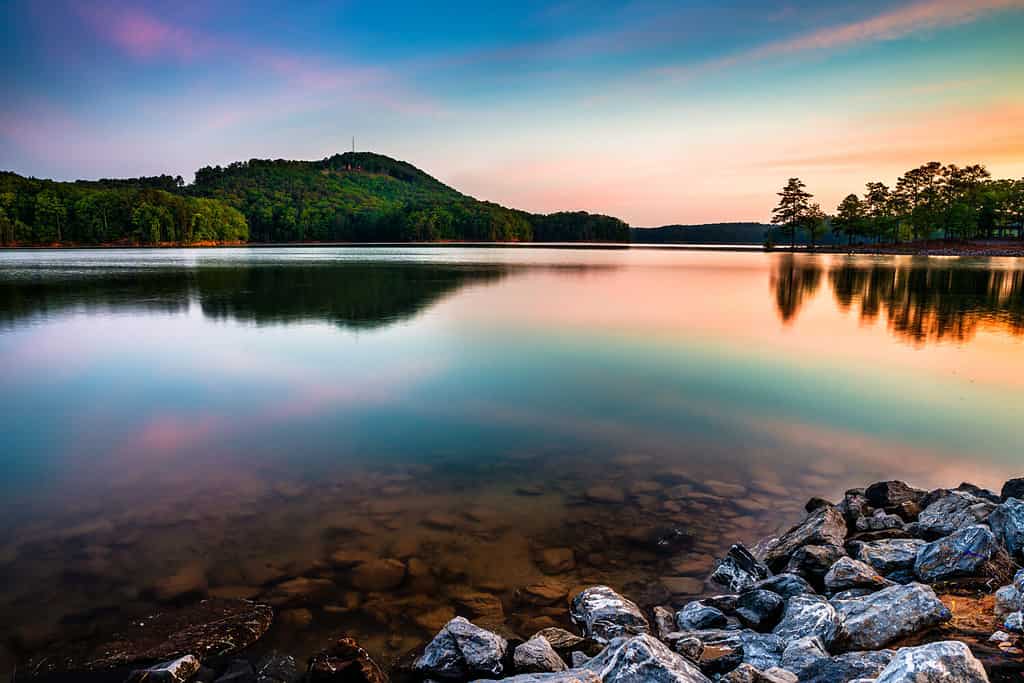Some of the most snake-infested lakes in the state of Georgia are highly populated areas, whether for recreational purposes, fishing, or homes on lakefront property. As a southern state, where the weather is traditionally warmer throughout the year, Georgia has its fair share of snake problems.

According to the Georgia Department of Natural Resources, there are 46 species of snake in Georgia, and snakes, follow a predictable pattern. Like every other living thing on the planet, snakes have at least three, basic needs—food, shelter, and water. A great big reservoir certainly meets one of those instinctive requirements.
However, a lake also meets the other two as well, at least indirectly. For those reasons, there are several lakes in Georgia where snake encounters are prevalent. This is especially true since people love to spend time on the water. When humans and snakes want the same thing, even though it’s for different reasons, the two worlds collide.
1. Lake Hartwell

Spotting an eastern copperhead along the shoreline on Lake Hartwell is more common than most people feel comfortable with.
©Facing West Images/Shutterstock.com
Lake Hartwell is bound to be the first lake to pop up when discussing snake-infested lakes in Georgia. It’s at the top of most lists, specifically when it comes to the eastern copperhead. The eastern copperhead is Georgia’s most aggressive snake. Yes, even compared to the cottonmouth (Water moccasin).
Spotting an eastern copperhead along the shoreline on Lake Hartwell is more common than most people feel comfortable with. It doesn’t help that they are one of the more common snakes in the state and the country’s southeastern region. Copperhead bites are extremely common in the US and Georgia is no exception.
However, copperheads aren’t the only snakes slithering around the swampy, forested edges of Lake Hartwell. You’ll also find cottonmouths, timber rattlesnakes, pygmy rattlesnakes, northern water snakes (which often highly resemble copperheads, leading to confused encounters), and a number of nonvenomous snakes as well.
2. Lake Lanier

Those engaging in various recreational activities on Lake Lanier will eventually spot one of the many, non-venomous snakes that call the lake their home.
©Brett Barnhill/Shutterstock.com
Snakes are frequently spotted throughout Lake Lanier and the surrounding areas. For the most part, it’s rat snakes, garter snakes, northern water snakes, and copperheads. Only the latter is truly dangerous and then, only if stepped on. Snakes in this Georgia lake are common enough to merit a snake-breakdown article in the Lakeside News.
According to the article, four of the six pit vipers found in Georgia are not present on Lake Lanier, and that includes water moccasins, which are seemingly synonymous with any body of water in the south. For the most part, those engaging in various recreational activities on Lake Lanier will eventually spot one of the many, non-venomous snakes that call the lake their home.
Timber rattlesnakes are the other venomous pit vipers found in the Lake Lanier region. However, timber rattlesnakes are far more likely to scurry off if they hear you approach. A copperhead, on the other hand, has a different defensive mechanism—freezing in place. This is why copperheads are stepped on more frequently than other snakes.
3. Lake Allatoona

With the millions of people flooding in and out each year, there are often a sizeable number of snake encounters.
©Rob Hainer/Shutterstock.com
Lake Allatoona is home to a huge population of water snakes, including northern, brown, banded, and common water snakes. The lake is a huge recreational attraction for locals and the tourism industry. With the millions of people flooding in and out each year, there are often a sizeable number of snake encounters.
While snakes in Georgia lakes are common enough, there seems to be a higher number of water snakes in Lake Allatoona specifically. On the bright side, water snakes are relatively harmless, other than eliciting a quick scare if you stumble on one.
As with most Georgia Lakes, there are copperheads here as well, mainly in the forested areas surrounding the lake. Since copperheads blend in best with leaves, they love to find themselves a good pile of them. A brush pile will do just as well in a pinch.
4. Pine Lake Western Wetlands

Pine Lake is on the line separating the non-water moccasin region from prevalent water moccasin areas.
©Thomson200, CC0, via Wikimedia Commons – License
If there’s one thing that snakes absolutely adore, it’s a good wetlands environment. The wetlands in and around Pine Lake are entirely man-made, using stormwater run-off that filters through a de-sedimentation pond, where the heavy particulates settle at the bottom.
Man-made or natural, snakes don’t care, and you’ll find many of the water snake types in Georgia Lakes within the Pine Lake Wetlands in extensive numbers. The plain-bellied water snake, common water snake, northern water snake, green water snake, and banded water snake call Pine Lake home.
As with just about every lake in Georgia, copperheads are here as well, along with timber rattlesnakes and pigmy rattlesnakes. Pine Lake is on the line separating the non-water moccasin region from prevalent water moccasin areas. They probably won’t venture that far into northern Georgia but it shouldn’t be a shock to find one on Pine Lake.
5. Seagrove Lake

Since this is the very southern portion of Georgia, water moccasins are very common here.
©Rafael R Sandoval/Shutterstock.com
Snakes in Seagrove Lake, Georgia are a very common sight. Seagrove Lake is a part of the larger, Okefenokee National Wildlife Refuge, which is also home to the Okefenokee Swamp. The wetlands in this area are of international importance.
Wherever there are wetlands, there are also snakes. Since this is the very southern portion of Georgia, water moccasins are very common here, along with copperheads and all of the water snakes common to the state of Georgia.
Sightings here are less frequent though that’s because the influx of people each year is not as big as it is in other lakes throughout the state. However, it is a park that offers a lot of recreational people. It’s also quite large, at just over 355,000 acres. Fortunately, snake bites are just as rare on Seagrove Lake as they are across the rest of the country. Though you might see one there, you’ll probably still have a great time.
Final Thoughts on Snake-Infested Lakes in Georgia
Lakes are synonymous with snakes, especially in the warmer environments of the south. Georgia is no exception to the rule and many of the lakes throughout the state are home to various snakes. Out of the 46 species known to reside in Georgia, only six are venomous.
Of the six, only one is aggressive—the eastern copperhead, more commonly known as a copperhead. Snake bites are very uncommon and deaths from those bites are rarer still. If you encounter a snake in one of Georgia’s many lakes, the odds are good that it’s nothing more than a relatively harmless water snake.
Summary of the Most Snake-Infested Lakes in Georgia
| Lake | Snakes | |
|---|---|---|
| 1 | Lake Hartwell | Copperheads, cottonmouths, timber rattlesnakes, pygmy rattlesnakes, northern water snakes, and more |
| 2 | Lake Lanier | Timber rattlesnakes, rat snakes, garter snakes, northern water snakes, and copperheads. |
| 3 | Lake Allatoona | Water snakes and copperheads |
| 4 | Pine Lake Western Wetlands | Plain-bellied water snake, common water snake, northern water snake, green water snake, copperhead, timber rattlesnake, pygmy rattlesnake, and banded water snake |
| 5 | Seagrove Lake | Copperheads, water moccasins, and other water snakes |
The photo featured at the top of this post is © Brett Barnhill/Shutterstock.com
Thank you for reading! Have some feedback for us? Contact the AZ Animals editorial team.






